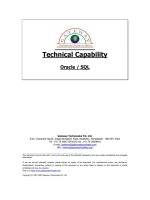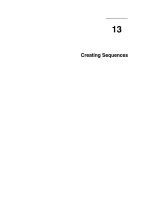Tài liệu DVD Movies docx
Bạn đang xem bản rút gọn của tài liệu. Xem và tải ngay bản đầy đủ của tài liệu tại đây (35.69 KB, 7 trang )
11.4. DVD Movies
Using DVD Player, newly enhanced in Leopard, your Mac can play Hollywood DVDs as
though it was born to do so.
Watching movies on your Mac screen couldn't be simpler: Just insert the DVD. The Mac
detects that it's a video DVD (as opposed to, say, one that's just filled with files) and,
unless you've fiddled with your preference settings, opens the DVD Player program
(Figure 11-9
). (It can take awhile.)
If DVD Player doesn't start up automatically when you insert a DVD movie, you can
open it yourself. It's sitting there in your Applications folder. (Then fix the problem,
using the CDs & DVDs panel of System Preferences.)
11.4.1. Playing a Movie
Once DVD Player starts playing your movie, you can use the "remote control," which is
deconstructed in Figure 11-9
. Or just use the keyboard controls:
• By far the easiest way to start and stop Playback is to press the Space bar—once to
start, again to pause, again to start again.
• Press Shift- - to fast-forward; press that combination repeatedly to cycle
from twice to 4, 8, 16, or 32 times normal speed. (Or just choose a speed from the
Controls Scan Rate submenu.)
Similarly, press Shift- - to scan backwards. Click Play (or press the Space
bar) to resume normal playback.
• You can make the movie louder or quieter by repeatedly tapping - , or -
. That's a good keystroke to remember when you've hidden the remote control
itself.
Figure 11-9. Top: DVDs on your screen!Use your mouse to click the buttons, if you
like; that's a lot more direct than having to use the arrow keys on a remote control.
Bottom: You can orient this controller either horizontally or vertically on your
screen by choosing Controls Use Vertical Controller. You can also do without
this remote control altogether, since all of its buttons have keyboard equivalents.
Or, if you prefer a clip 'n' save cheat sheet of all the keystrokes, here it is:
Function Keystroke
Play, Pause Space bar
Fast-forward
Shift- -
Rewind
Shift- -
Skip back 5 seconds
Option- -
Skip forward 5 seconds
Option- -
Louder
-,
Quieter
Mute/Unmute
Option- - .
Next/previous "chapter"
,
Main menu
-~ (upper left of your keyboard)
Full-screen mode
-F
Half, normal, maximum size
-1, -2, -3
Eject
-E
Show/hide remote control
Option- -C
Add a bookmark
-= (equal sign)
Tip: Isn't that cool how DVD Player automatically displays the subtitles for the dialog (if
subtitles exist on the DVD) when you hit the Mute key?
11.4.2. Full-Screen Playback
In Leopard, DVD movies begin playing back in in full-screen mode all by themselves
(you no longer have to choose View Enter Full Screen). Even the menu bar
disappears. (To make it reappear, move your cursor near the top of the screen.)
As shown in Figure 11-10
, though, a new suite of powerful navigation controls is still
available, even in full-screen mode.
Figure 11-10. Even in full-screen mode, you can control the playback and navigate
the disc using the new, translucent, pop-up control bars.
The chapter list appears when you move your cursor to the top of the screen. The
"remote control" bar appears when the cursor approaches the bottom.
One especially cool feature is the new Player Settings button. It opens the Zoom
controls window shown here, which gives you manual control over the width and
height of the picture on your screen.
Don't miss the scrubber bar at the very bottom, either. It lets you scroll directly to
any spot in the DVD.
11.4.3. Language Fun
Most Hollywood DVDs have been programmed with onscreen subtitles to help those
with hearing impairments and people sitting in noisy bars. Click the Subtitle button
(Figure 11-9
) to turn on the subtitles, and click again to hide them. (You can specify the
language you want—English subtitles, Spanish subtitles, or whatever the DVD offers—
by clicking the same button repeatedly. Or choose DVD Player Preferences, click the
Disc Setup icon, and choose a language from the Subtitle pop-up menu.)
Meanwhile, each time you click the Audio button on the remote, the movie's soundtrack
switches to a different language (if, in fact, alternate soundtrack languages have been
provided). You'll see the name of each language appear briefly in the remote's "display."
(You can also use the Audio button as a pop-up menu to choose the language you want
directly.)
Tip: For real fun, turn on English subtitles but switch the soundtrack to a foreign
language. No matter how trashy the movie you're watching, you'll gain much more
respect from your friends and family when you tell them that you're watching a foreign
film.
11.4.4. Bookmarks and Video Clips
Two DVD Player features are designed to help you flag and return to favorite moments
or scenes in a DVD movie.
• Bookmarks. Each time you find a spot you'll want to find again later (during
playback or when paused),hit -= (equal sign),or choose Controls New
Bookmark. DVD Player invites you to name the bookmark. You can also accept
its proposal of 1:23:15 (or whatever the hours:minutes:seconds count happens to
be).
Once you click OK, you can use the Go Bookmarks submenu to jump from
one bookmark to another.
Tip: Ordinarily, DVD Player is smart enough to begin playing back a movie from
the point where you stopped, even if you ejected the DVD in the meantime and
three years have gone by.But when you create a bookmark, the "Name your
bookmark" dialog box offers you the chance to define a default bookmark. That
means, "Next time you insert this disc, play back from here instead of where I
stopped."
Figure 11-11. When you choose Controls New Video Clip, this box
appears. Find the starting point of the favorite scene and then click the upper
Set button. Now play or navigate to the end of the scene, and click the lower
Set button. When you click Save, you're invited to name the scene. From now
on, you can play the scene by choosing from the Go Video Clips submenu.
• Video Clips. A video clip is exactly the same as a bookmark, except that you're
supposed to designate a starting point and an ending point. (Don't get excited; a
video clip isn't a standalone file that's saved on your computer, and you can't send
it or share it. It only works within DVD Player.)
Figure 11-11
shows how you create and use a video clip.
11.4.5. Chapter Thumbnails
There are roughly 7 trillion different ways to navigate a DVD now, but one of them lets
you have a little creative fun: You can create your own scene thumbnails.
That might not be an especially tempting feature when you're playing Hollywood DVDs.
But on homemade DVDs, made either by you or somebody else, these custom scene
markers can be handy signposts.
First choose Window Chapters ( -B) to open the new chapter thumbnail palette.
Here you'll find the existing scene breaks, which may or may not already have "poster
frame" images (Figure 11-12
).
All the action takes place in the Action menu at the bottom of the panel. For
example, it contains the Generate Missing Thumbnails command, for use on DVDs that
have chapter breaks but no little poster frames to represent them.
Whether there is a poster frame for a particular chapter or not, you can substitute an
image of your own. Find the exact frame of the movie that you think looks better than
what's already in the Chapters palette; click the chapter in the palette, and, from the
pop-up menu, choose Use Current Frame for Thumbnail. Presto: You've replaced the
unhelpful (or nonexistent) chapter image with one that works better.
FREQUENTLY ASKED QUESTION
Region Changing
The first time I tried to play a DVD, I got this weird message about initializing
the region code. What's up with that?
Hollywood generally releases a movie in each part of the world at different
times. A movie may come out on video in the U.S. when it's just hitting screens
in Europe. We certainly can't have people watching a DVD before the movie
studio says it's OK! That's why many discs are region-locked, so that they play
back only on players in certain geographical regions.
As a DVD player in disguise, your Mac is just doing its duty. You can change
its region (you'll be offered the chance to do so when you insert a region-locked
DVD from another region), but only five times—and then it's frozen forever in
the fifth version.
The dialog box shows you which region your DVD is designed for: 1 for the
U.S. and Canada; 2 for Japan, Europe, South Africa, and the Middle East; 3 for
Southeast and East Asia; 4 for Australia, New Zealand, Pacific Islands, Central
America, Mexico, South America, and the Caribbean; 5 for Eastern Europe,
Africa, and North Korea; 6 for China; and 8 for airplanes, cruise ships, and so
on. Any DVD that you burn yourself is assigned region 0, meaning that it will
play anywhere.
(There's no Region 7. Maybe it's reserved for the empty spot in movie
executives' hearts.)
11.4.6. The Big Picture
Now, watching a movie while sitting in front of your Mac is not exactly the great
American movie-watching dream. Fortunately, every recent Mac model has a video-
output jack; with the proper cables, you can connect the Mac to your TV for a much more
comfortable movie-watching experience.
Figure 11-12. Double-click a chapter thumbnail to jump to that spot in the video.
Use the pop-up menu at the top to switch between Chapters, Bookmarks, and Video
Clips you've made. And use the menu at the bottom to manage the chapters'
names and images.
GEM IN THE ROUGH
Parental Controls
The new parental controls in Leopard aren't much. You can't say, for example,
"Don't play anything rated PG-13 or above"; you have to rate each DVD
yourself, one at a time.
But they're better than nothing.
Insert the DVD you're worried about. Choose File Get Disk Info. Click the
Parental Controls tab.
Click the button and enter your administrator's password. (Unless, of
course, your 8-year-old is the administrator of this Mac instead of you, in which
case this DVD is the least of your problems.)
Now you can select either "Always ask for authorization" or "Always allow to
be played," depending on your feelings about this movie. Click OK.
All you've done so far, however, is to specify what happens when you turn on
parental controls—and you haven't done that yet. Choosing Features Enable
Parental Control does the trick.
When parental control is turned on, nobody's allowed without watch the "always
ask for authorization" DVDs unless they correctly input your administrator's
password.
Which nobody knows except you. (Right?)
Just be sure to connect the cable directly to the TV. If you connect it to your VCR
instead, you'll probably get a horrible, murky, color-shifting picture—the result of the
built-in copy-protection circuitry of every VCR.
Or what the heck—just ask for an Apple TV for your birthday.









